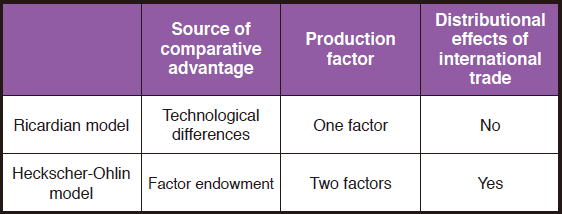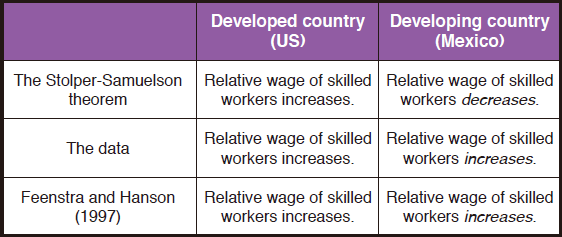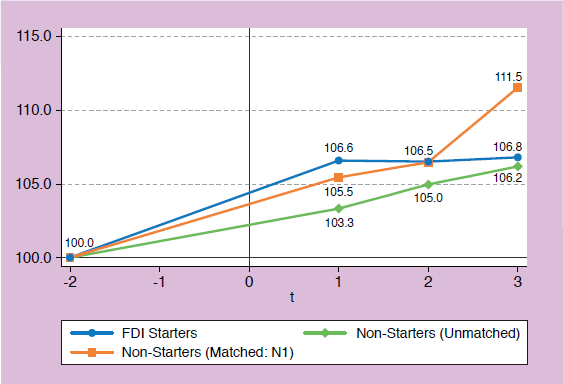PDF version [PDF:395KB]
Introduction
How international trade affects wage inequality is one of the major questions in international economics. This question is so important that many researchers have already examined it. It is closely related to another question—how international trade affects income inequality—since wage inequality can result in income inequality. This article reviews the previous studies and reexamines the old questions from a Japanese point of view..
A remarkable feature of the Japanese labor market is that there is a dual market, in the sense that a labor market for temporary workers exists separately from that for permanent workers. The rapid growth in the number of temporary workers in Japan during the 2000s generated greater income inequality and greater job insecurity because temporary workers' wages are lower and their jobs are more tenuous than those of permanent workers. This article examines whether globalization affects this situation.
Traditional Trade Theory
International trade theory began with David Ricardo's On the Principles of Political Economy and Taxation (1817). In his book, he described the hypothetical situation in which two countries, Britain and Portugal, traded wines and clothes with each other, based on their comparative advantage. In his theory of comparative advantage, both countries obtained gains from international trade. While his theory focused on country-level gains to abolish the Corn Laws, it says nothing about income inequality within a country.
However, freer trade can create winners and losers in many cases. In order to produce benefits from free trade, Ricardo supported the abolition of the Corn Laws, which restricted imports of foods by tariffs to protect domestic food producers (the Corn Laws were eventually repealed in 1846, some 23 years after his death). Prof. Paul Krugman of the City University of New York, however, pointed out in his popular textbook International Economics: Theory & Evidence (2009) that imports of foods would have had negative impacts on landowners, while it would have had positive impacts on capitalists. The Ricardian model is too simple to examine the effects of international trade on income distribution. We need more complicated trade models to discuss the distributional effects of international trade (Table 1).

In the early 20th century, two Swedish economists, Eli Heckscher and Bertil Ohlin, first presented the so-called Heckscher-Ohlin model. Heckscher published his paper "The Effect of Foreign Trade on the Distribution of Income" in 1919 and Ohlin published his book Interregional and International Trade in 1933. Their model was mathematically formulated by Paul Samuelson, Ronald W. Jones, and others in following years.
The Heckscher-Ohlin model also explains trade patterns by the concept of comparative advantage but focuses on differences in factor endowments across countries rather than technological differences which the Ricardian model focuses on. The Ricardian model considers one production factor (labor) but the Heckscher-Ohlin model considers two production factors, for example, labor versus capital or skilled versus unskilled workers. The Heckscher-Ohlin model predicts that a labor-rich country exports labor-intensive goods, while a capital-rich country exports capital-intensive goods. It also predicts that developed countries where skilled workers are abundant export skill-intensive goods, while developing countries where unskilled workers are abundant export unskilled-intensive goods.
The Stolper-Samuelson theorem, one of the theorems of the Heckscher-Ohlin model, was formulated in Wolfgang Stolper and Paul Samuelson's paper "Protection and Real Wages" in Review of Economic Studies (1941). It provided a theoretical prediction that international trade widened wage inequality in developed countries such as the United States, while it reduced wage inequality in developing countries. This is because the relative wage of skilled workers increases in developed countries that export skill-intensive goods, while the relative wage of unskilled workers increases in developing countries that export unskilled-intensive goods.
Many empirical works have revealed that the Stolper-Samuelson theorem's prediction was inconsistent with the real world in both developed and developing countries. In developed countries like the US, the price movement of goods was inconsistent with the theory. Most economists considered that skill-biased technological change was the more plausible explanation for the rise in wage inequality. In many developing countries including Mexico, India, and China, wage inequality rises, against the prediction of the Stolper-Samuelson theorem. Inconsistency between the Stolper-Samuelson theorem and the empirical evidence strongly suggested that globalization in the form of freer international trade was not the primary source of rises in wage inequality (Table 2).

Offshoring and Inequality
The failure to explain the empirical facts resulted in new models which aimed to reconcile trade theory with the data. Prof. Robert Feenstra of the University of California, Davis, and Prof. Gordon Hanson of the University of California, San Diego, presented one such new model. Their 1997 paper in Journal of International Economics, "Foreign Direct Investment and Relative Wages: Evidence from Mexico's Maquiladoras", presented a theoretical model that could explain the rise in wage equality in both developed and developing countries such as the US and Mexico. Their model took the possibility of foreign outsourcing into account to explain the rise in wage inequality in the US and Mexico. It featured the fact that firms in the US outsourced less skilled activities to Mexico where the outsourced activities were more skill-intensive than any other activities previously done. This type of foreign outsourcing brought about an increase in demand for more skilled workers in both the US and Mexico, resulting in the rise in wage inequality in both countries.
How foreign outsourcing affect wage inequality was further examined by many subsequent studies. Prof. Gene Grossman and Prof. Esteban Rossi-Hansberg, both of Princeton University, presented a simple and general model of offshoring in their 2008 paper "Trading Tasks: A Simple Theory of Offshoring" in American Economic Review. They also explained their model in The Rise of Offshoring: It's Not Wine for Cloth Anymore (2006). They argued that offshoring could have three effects on wages for low-skilled workers: (1) productivity effect, (2) relative-price effect, and (3) labor-supply effect. The relative-price effect and labor-supply effect give rise to a decrease in wages for low-skilled workers. The productivity effect is important for low-skilled workers because it indicates that offshoring can increase low-skilled workers' wages. This effect is caused by the mechanism that offshoring enhances firm productivity and raises demand for low-skilled workers. Because of the productivity effect, offshoring can generate gains for low-skilled workers as well as high-skilled workers. However, the sign of the overall effects on low-skilled workers' wages depends on whether the positive productivity effect surpasses two negative effects: the relative-price effect and labor-supply effect (Table 3).

Prof. David Hummels of Purdue University and others empirically examined the wage effects of offshoring in their paper "The Wage Effects of Offshoring: Evidence from Danish Matched Worker-Firm Data" which appeared in American Economic Review in 2014. They utilized the large-sized data covering the population of Danish workers and the universe of private Danish firms. They also merged their firm-worker matched data with the product-level trade data, to investigate the wage effects of offshoring. They concluded that offshoring decreased wages for the low-skilled workers and increased wages for the high-skilled workers in the case of Denmark. Their study does not imply international trade is bad for low-skilled workers because it also pointed out that exporting increased wages for the low-skilled workers as well as high-skilled workers. Even though international trade affects wages for both types of workers, its magnitude is relatively small. The wage elasticity of offshoring for low-skilled workers is about -0.022 and that of exporting is about +0.05.
Dr. Daniel Baumgarten of the University of Munich and others studied the effects of offshoring on wages using German data. Their empirical results are shown in their paper "Offshoring, Tasks, and the Skill-wage Pattern" in European Economic Review (2013). They found negative effects of offshoring on wages for both low- and high-skilled workers. They also found that the effects depend on the degree of offshorability. The wage reduction due to offshoring tends to be more severe for workers whose occupational tasks are less interactive and have higher routine content. They argued that workers whose tasks were less interactive faced larger wage reductions because of a higher degree of offshorability.
Dr. Avraham Ebenstein of Hebrew University of Jerusalem and others studied the case of the US in their paper "Estimating the Impact of Trade and Offshoring on American Workers Using the Current Population Surveys" in Review of Economics and Statistics (2014). Their analysis indicates that workers who changed their jobs due to international trade experienced real wage loss of 12 to 17 percentage points between 1983 and 2002. They, therefore, insisted that labor market frictions were not negligible. This conclusion is similar to another empirical work by Prof. David H. Autor of the Massachusetts Institute of Technology and others, "Trade Adjustment: Worker-Level Evidence" in Quarterly Journal of Economics (2014). Autor employed longitudinal data on individual earnings by employers and examined the impacts of import competition on earnings and employment in the US between 1992 and 2007. Their analysis revealed that worker-level adjustment costs to import shocks were significant.
To summarize, there are mixed empirical results for the wage effects of offshoring. On the one hand, some studies claimed that the negative effects of trade and offshoring are negligible. On the other hand, other studies presented significantly negative effects of trade and offshoring. Grossman and Rossi-Hansberg's famous theoretical model predicts that there are both negative and positive effects of offshoring for low-skilled workers since offshoring brings about possible positive effects for low-skilled workers due to improvement of firm productivity. Whether offshoring widens wage inequality remains an unsolved question. More empirical studies are required to clarify the wage effects of offshoring.
Wage and Income Inequality in Japan
Studies by labor economists show us the distinctive features of the Japanese labor market. In their influential paper "Wage Distribution in Japan, 1989-2003" (Canadian Journal of Economics, 2008), Prof. Ryo Kambayashi of Hitotsubashi University, Prof. Daiji Kawaguchi of the University of Tokyo, and Dr. Izumi Yokoyama of Hitotsubashi University stated that "while the debate about the reason for broadened inequality is heating up, the premise of the debates—that Japan has experienced widening inequality—has not yet been decisively confirmed." There was a famous debate between two leading labor economists, Prof. Toshiaki Tachibanaki of Kyoto University and Prof. Fumio Ohtake of Osaka University. While Tachibanaki insisted that income inequality widened in the 1980s and 1990s, Ohtake argued that the aging of the population mechanically widened income inequality since the degree of income inequality is high among elderly people.
To answer this unsettled question, in their above paper Kambayashi and the others investigated how wage distribution in Japan evolved. To do so, they employed detailed wage data from the Basic Survey on Wage Structure (1989-2003, Chingin Kozo Kihon Tokei Chosa in Japanese). They pointed out that the between-group wage inequality was declining during their sample period if the group was defined by education, experience, tenure, and firm/establishment size. The reason for the declining trend of between-group wage inequality was the decline of the return to education and job tenure. The authors suggested that the increase in the supply of college-educated and long-tenured workers resulted in a lower return to education and job tenure. Their results contrast with the situation in the US where a larger return to education brought about wider wage inequality. Kawaguchi and Dr. Yuko Mori tried to answer why wage inequality has not increased in Japan unlike in the US. Their paper in Economics of Education Review (2016) pointed out that the college wage premium, i.e. wage gap between high-school graduates and college graduates, decreased in Japan between 1986 and 2008, while it increased in the US during the same period. They analyzed the micro data from the Basic Survey on Wage Structure as well as the Labor Force Survey (Roudou Ryoku Chosa in Japanese) and made a comparison between Japan and the US. They found that the number of college graduates increased more rapidly in Japan than in the US. While Prof. David Card of the University of California, Berkeley, and Prof. Thomas Lemieux of the University of British Columbia, in their famous paper in the Quarterly Journal of Economics (2001), argued that the reason for the rising college wage premium was the slowdown in the relative supply of college graduates in the US, Kawaguchi and Mori argued that the same mechanism worked in Japan in the opposite way and that the rapid growth in the supply of college graduates could explain the decrease in the college wage premium in Japan.
Globalization and Inequality in Japan
Lack of adequate data has prevented trade economists from investigating how international trade affects wage inequality in Japan. Very few studies examined the case of Japan on the relationship between international trade and wage inequality. Prof. Keith Head and Prof. John Ries, both of the University of British Columbia, are well-known experts in the field of the Japanese economy because they have intensively studied Japanese trade and FDI. One of their early studies, "Offshore Production and Skill Upgrading by Japanese Manufacturing Firms" in Journal of International Economics (2002), investigated how Japanese firms' offshore production affected onshore skill intensity. They found that an increase in foreign employment due to offshore production in low-income countries raised skill intensity in Japan. Higher demand for skilled workers can potentially increase the relative wages of skilled workers and widen wage inequality.
Recently some trade economists have started studying the impacts of globalization on wage and income inequality in Japan, using new data. Prof. Masahiro Endoh of Keio University conducted the first study to examine the impact of offshoring and exports at the worker-level in Japan, in his unpublished paper entitled "The Effect of Offshoring on Skill Premiums: Evidence from Japanese Matched Worker-Firm Data". He made a first set of Japanese matched employer-employee data to examine the impact of offshoring and exports. Using the instrument variable technique, his study found that offshoring and exports had significant impacts on the wages of Japanese workers. It provided evidence that offshoring had positive impacts on Japanese workers' wages, while exporting had negative impacts. This result is surprising and difficult to explain. More studies are required to analyze the impacts of offshoring and exports in Japan.
The Trade, Growth and Economic Inequality Project
In 2016, Prof. Kozo Kiyota of Keio University, Prof. Fukunari Kimura of Keio University, and I joined the international research project "Trade, Growth and Economic Inequality in the Asia-Pacific Region" which was led by Prof. Theresa Greaney and Prof. Baybars Karacaovali, both of the University of Hawai'i at Mānoa, and was mainly financed by the Japan Foundation Center for Global Partnership. The project aimed at investigating the linkages between international trade and investment, economic growth, and economic inequality in the Asia-Pacific region and consisted of economists from China, Japan, South Korea, and the US. The conferences were held at University of Hawai'i at Mānoa and Keio University in 2016. The resulting research papers were included in a special issue of Journal of Asian Economics (2017). Policy implications were presented in a short paper by Greaney and Karacaovali in Journal of Economics and Political Economy (2017). In their paper, Greaney and Karacaovali concluded that "relationships between international trade, foreign direct investment (FDI), economic growth and inequality are extremely complicated, so no single theory should be relied upon for policy guidance." (Photo)

In the project, I focused on the remarkable feature of the Japanese labor market that temporary workers receive less wages and lower job security than permanent workers. The Labor Force Survey shows that temporary workers such as part-time workers and contingent workers account for more than one-third of the labor force as of 2011. The increase in the share of temporary workers can result in the rise in income inequality. In fact, the Japanese government regards the growth in the share of temporary workers among total workers as a major cause of rising income inequality. In the Annual Report on the Japanese Economy and Public Finance 2009, the Cabinet Office analyzed data from the Employment Structure Survey (Shugyo Kozo Kihon Chosa in Japanese) and argued that the wage income gap continues to expand and that the increase in the share of temporary workers (non-regular workers) among total workers has largely contributed to the expansion of the wage income gap between 1997 and 2007.
My study in the special issue of Journal of Asian Economics, "Foreign Direct Investment and Temporary Workers in Japan", investigated the relationship between Japanese firms' globalization in the form of outward FDI into Asian countries and domestic growth in the temporary workforce in manufacturing industries. I used firm-level data between 2001 and 2013 from the Basic Survey of Japanese Business Structure and Activities (Kigyo Katsudo Kihon Chosa in Japanese) and employed standard econometric techniques. In Japan, the share of temporary workers rose during the 2000s. In 2004, deregulation accelerated their rising numbers by enabling manufacturers to employ temporary workers indirectly through employment services (dispatched workers).
During the sample period, Japanese firms increased vertical FDI or offshoring. Offshoring enables firms to employ workers in low-wage countries. Whether offshoring substitutes for employing temporary workers is, however, a less explored question. Using Italian firm-level data, Dr. Andrea F. Presbitero of the International Monetary Fund and others examined whether the employment share of temporary workers affected offshoring in their paper in International Economics (2015). They found that firms with higher ratios of temporary workers exhibited reduced tendencies to offshore but that this relationship vanishes after controlling for endogeneity. My study focused on four industries in Japan's machinery manufacturing sector noted for vertical FDI. It particularly investigated the causal effects of vertical FDI on wages and employment shares of temporary workers (Chart).

My study found that there were positive effects of vertical FDI on the wages and employment share of temporary workers one year after starting FDI but they vanished in subsequent years. Therefore, it concluded that the relationship between temporary workers and vertical FDI was complementary in the early stage of FDI and that no persistent effect of vertical FDI occurred. Offshoring might result in widening income inequality by increasing the share of low-wage temporary workers. However, my study found no evidence that FDI in Asia induced firms to increase the employment share of temporary workers. In other words, it found little evidence for the contention that vertical FDI results in greater income inequality and greater job insecurity through increasing the share of temporary workers.
Conclusion
Prof. Elhanan Helpman of Harvard University, in his Keynes Lecture in Economics delivered at the British Academy in 2016, summarized previous studies and concluded that international trade played an important role in increasing wage inequality, but that its cumulative effect has been modest. However, most studies in the field of international trade and wage inequality have focused on the US. The Japanese situation is very different from that of the US. First, labor economists suggested that wage inequality has not increased in Japan unlike in the US because the wage gap between high-school graduates and college graduates decreased in Japan due to increased supply of college graduates. Second, the Japanese government considered that the increase in the share of temporary workers among total employment widened income inequality. These two facts require trade economists to further investigate how globalization in the form of trade, FDI, and offshoring affect the share of temporary workers in Japan. My own studies suggest that globalization did not play any persistent role in the rise in income inequality in Japan.
This article first appeared on the November/December 2017 issue of Japan SPOTLIGHT published by Japan Economic Foundation. Reproduced with permission.
November/December 2017 Japan SPOTLIGHT


